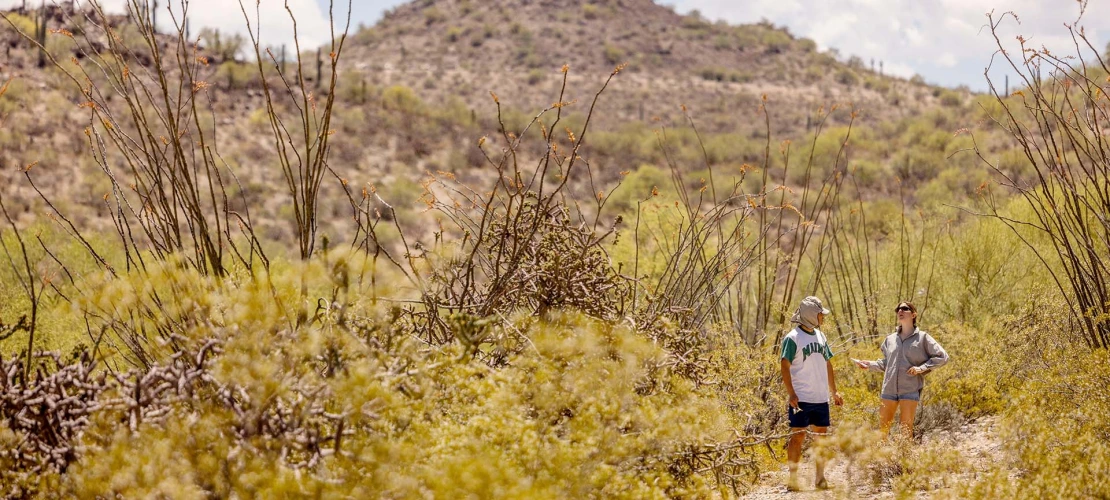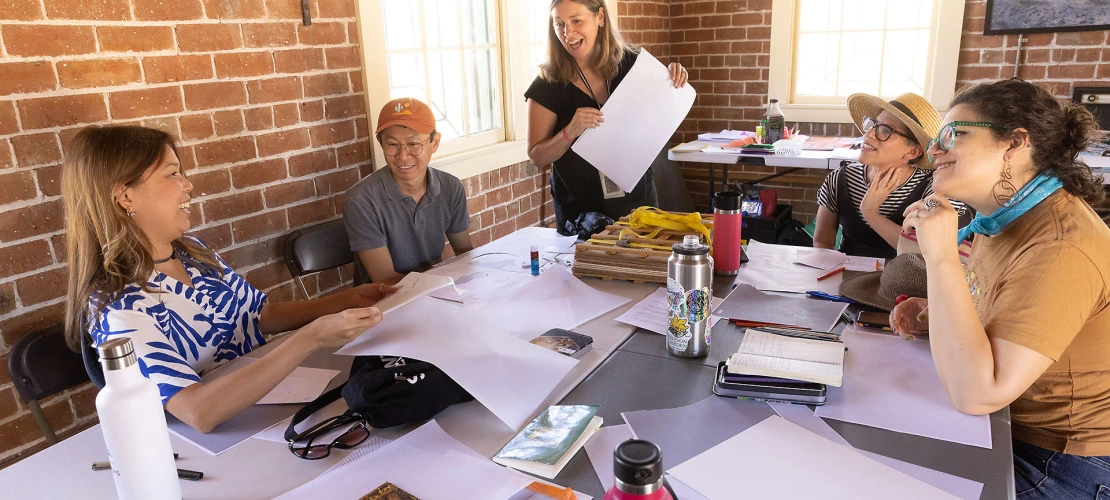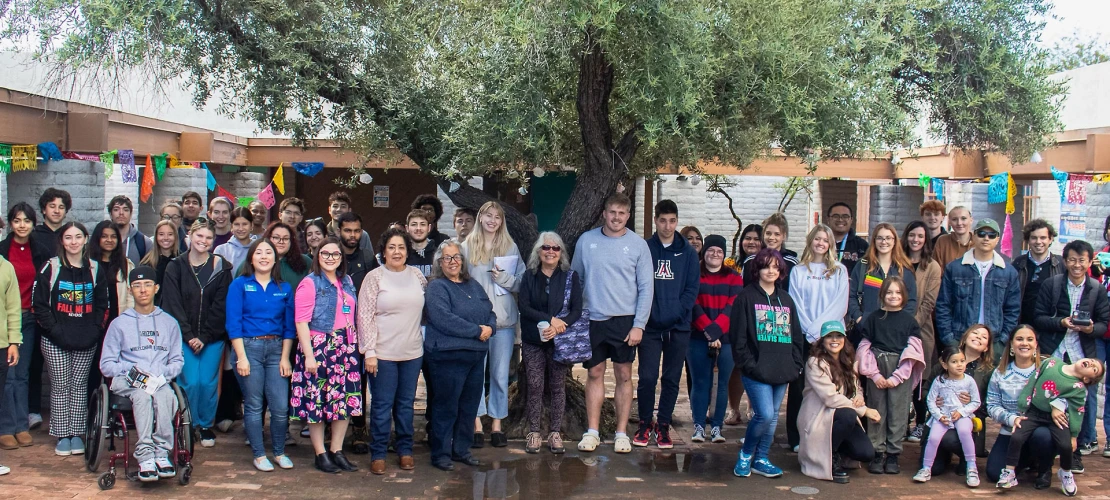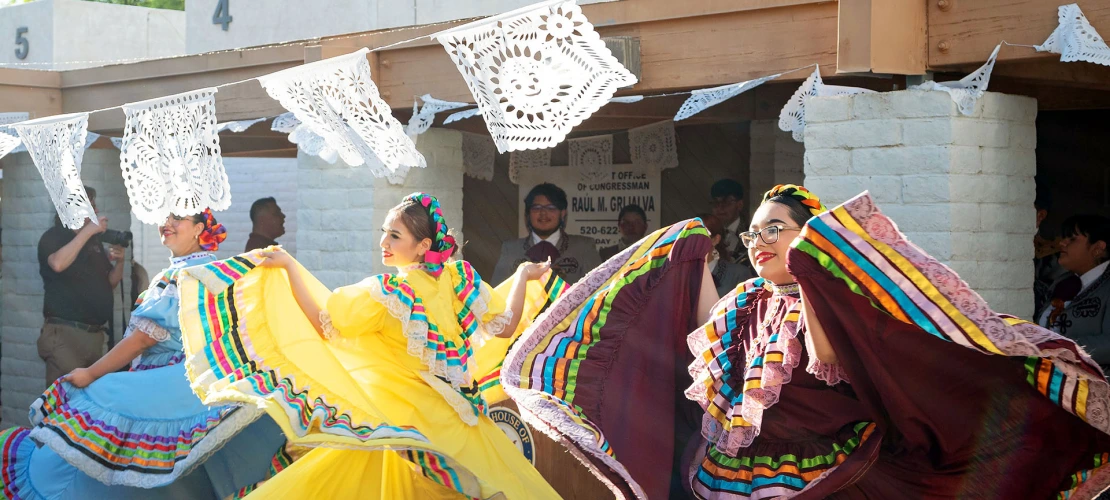Resilience Blooms in the Desert
Arizona Arts builds community connections through interdisciplinary collaborations.

Folklórico dancers from Desert View High School perform at iFiesta Fotográfica!, an exhibition celebrating El Pueblo Neighborhood Center.
Jessica Wolff
On a balmy Saturday night in May, the sound of mariachi fills the air. Music students from Sunnyside High School are singing joyous songs in Spanish. Three young women dressed in bright yellows, blues and reds are performing folkloric dances of Mexico for a lively audience of friends and family, local politicians, and neighborhood activists. Everyone in the crowd is loving it.
The fiesta at El Pueblo Neighborhood Center in Tucson celebrated a long eff ort to revitalize the site and honor the people of the city’s south side. Beginning in 1975, the center was a hub of community and family activity, a site for everything from weddings and quinceañeras to a preschool and a library. Recently, however, use of the center for such communal activities had declined.
Around 2017, things began to change. Congressman Raúl Grijalva moved his local offices there, and the city government joined a number of neighborhood organizations to begin reinvestment. In the past year, a trio of University of Arizona scholars and a large group of their students also joined the eff ort to revitalize the center.
Ellen McMahon ’83, associate dean of the College of Fine Arts, tells the story of how the university got involved through the Arizona Institute for Resilience, or AIR. The institute focuses primarily on environmental issues but this year provided $75,000 in grant funding to the College of Fine Arts to increase its engagement with the arts and humanities. Called Arts|Humanities|Resilience grants, the awards support projects that use AIR research methods to build resilience in individuals and communities.
“It was really great,” McMahon says. “These interdisciplinary collaborations illustrate the inherent ability of arts research to transcend disciplinary silos and create meaningful connections with communities.”
The grants have supported five multidisciplinary projects with collaborations that ranged from visual arts, photography, documentary fi lm and creative writing to museum studies, public humanities, architecture and climate science. Among the projects, scholars paired up to focus on work at El Pueblo and at Tumamoc Hill on Tucson’s west side.
“Documenting Resilience in Tucson’s Southside,” for instance, enabled three UArizona scholars — Meg Jackson Fox, curator at the Center for Creative Photography, or CCP; Jacqueline Barrios, assistant professor of public and applied humanities; and Kenny Wong, lecturer in sustainable built environments at the School of Landscape Architecture and Planning — to continue the work highlighted at the fi esta with the El Pueblo neighborhood’s residents.
“We were really interested in using photography and the arts more broadly as a tool within community work,” Jackson Fox says. “How can photography participate in what it means to build a community?”
In partnership with the CCP and the Sunnyside Foundation, Barrios created the undergraduate class “El Pueblo Urban Humanities Studio.” Students researched their own projects and collected oral histories from community members and leaders, including Grijalva.
Wong, the third member of the trio, devoted his undergraduate capstone seminar for architecture majors entirely to El Pueblo. His students created model designs that reimagined the buildings and landscapes around the center in ways that would make them sustainable.
The trio worked closely with two community artists-in-residence for the project, funded by AIR. Muralist Jessica Wolff ’23 collected old family photos of the neighborhood and turned them into collages.
On the night of the party, the collages went on display at the center for all to see, to the delight of audience members who recognized friends and family in the images. In another room, Luis Fernando Gonzalez’s video documentary about the early years of the center was projected. Later, Jackson Fox exhibited selections of the student and community work at the CCP.
As Barrios puts it, “We all tried collectively to tell the story of El Pueblo and what it means to be from this place.”
Six miles north of El Pueblo, Tumamoc Hill is used daily by scores of walkers who brave the steep 1.5-mile road that climbs 700 feet above West Anklam Road. At the top, they are rewarded with stunning panoramic views of the Santa Cruz Valley and the city. The hill, covered with gigantic saguaros and a forest of ocotillos, creosote and mesquites, is a reserve for all kinds of birds and desert animals.
Tumamoc has hosted a desert laboratory since 1903, and in 1956, UArizona purchased the reserve and became the hill’s steward. Many, including McMahon, think it’s a perfect place to bring the arts, sciences and humanities together through poetry, photography and climate studies. When McMahon learned that artist and experimental philosopher Jonathon Keats was working on a project there, she suggested he team up with Carissa DiCindio, a UArizona assistant professor of art and a specialist in museum studies. Their proposal, “The Nature of Change: Experiments in Societal Transformation through Environmental Art in Tucson and the Sonoran Desert,” was funded by the grant program.
Keats is known internationally, especially for his work in deep-time photography. One of his methods is the pinhole camera, a technology dating from the fi fth century B.C. that joins science with art in a simple device anyone can make.In May, Keats and DiCindio held a community workshop at Tumamoc for participants to make their own pinhole cameras. “We were given little wooden boxes, about three or four inches square,” McMahon says. “He drilled holes in each of them and gave us a small piece of copper that had a more durable hole and then a black piece of paper. We cut the paper to the right size and glued the metal pinhole and paper onto the inside of the camera.”
Unlike a camera with a shutter, a pinhole camera can function in place for long periods of time. The workshop participants did not keep the cameras they constructed — instead, they were to place them somewhere in the city and leave them there for a hundred years. The cameras, of course, would outlive their makers, so participants were asked to find a caretaker, who in turn would also pass the job on.
The plan is that the cameras will be retrieved in 2123, and the photographs will go to the CCP. Keats hopes that people of that time will be able to see images that will have recorded changes in the landscape.
“The whole point, really, is to invite people to think about time diff erently by thinking 100 years into the future,” McMahon says. How are the saguaros doing now? How will they look a hundred years from now? And perhaps people will think, she says, “What can I do to make sure, in a time of climate change, that these beautiful cacti are still here?”
For another project last year, Keats collaborated with Regents Professor Ofelia Zepeda, a Tohono O’odham poet and linguist, and Raquel Gutiérrez, a Tucson-based poet. They called the project “Future Climate Proverbs.” Each of them wrote interactive prompts for proverbs that for a time were displayed on slates along the pathway on Tumamoc. With the new funding from AIR, Keats and DiCindio held a workshop for community members to write environmental proverbs of their own.
“There are some proverbs that apply to every place all around the world,” Keats says. Like “red sky at night, sailors’ delight.”
“And then there is the possibility of creating new proverbs,” he continues, like proverbs about climate change and the environment.
For the proverbs workshop, participants also gathered at Tumamoc. They were invited to climb the hill, to walk among the ocotillos and saguaros, and to get inspired to write proverbs of their own. Some walked in groups, some walked alone, but everyone wrote poetic meditations about nature. Here are two:
Admire the mother roadrunner,
spreading her wings in flight.
Yet beware she’s coming straight at you,
protecting her baby from the world.
The shade of a big tree can stunt
or foster community.
Resilience blooms in the desert.
The Center for Creative Photography plans an exhibition in October 2023 featuring the five projects sponsored by AIR.




